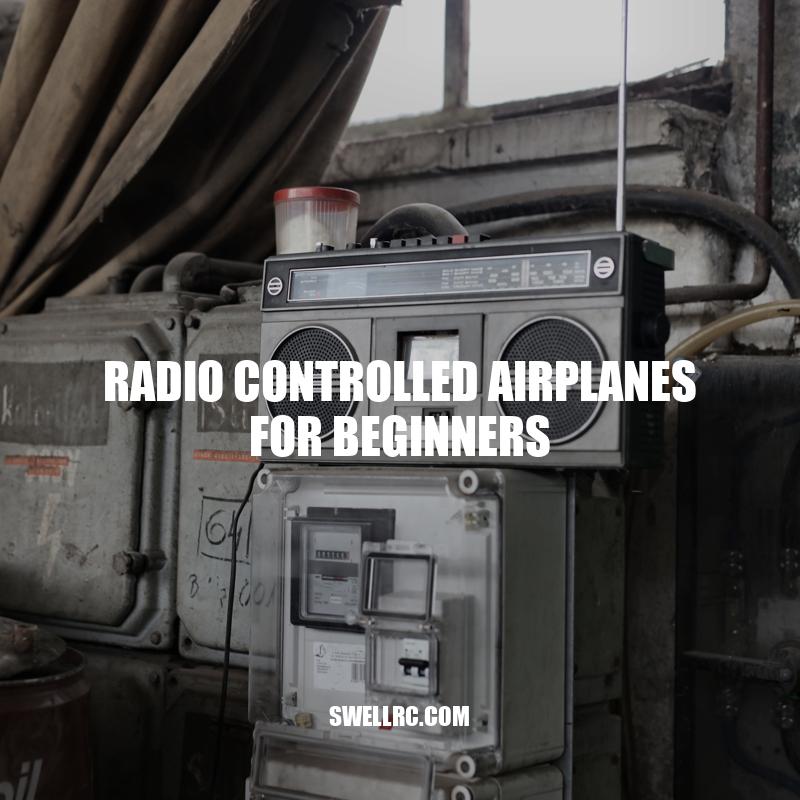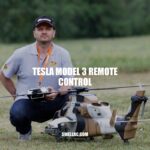Beginner’s Guide to Radio Controlled Airplanes
Radio controlled airplanes have become increasingly popular as a hobby among beginners who want to experience the thrill of flying. Whether you’re a young enthusiast or an adult looking to indulge in a new passion, this hobby can offer hours of fun and excitement. However, getting started with radio controlled airplanes can be overwhelming, especially if you don’t know where to begin. With a wide range of models, features, and accessories available in the market, it can be challenging to find the right one for your skill level, budget, and flying location. That’s why this article is designed as a guide to help beginners navigate the world of radio controlled airplanes. In the following paragraphs, we will discuss the types of RC airplanes, how to choose the right model, what to expect in terms of assembly and flight training, and how to join a community of like-minded enthusiasts.
Types of Radio Controlled Airplanes
When it comes to radio controlled airplanes for beginners, there are a few different types to choose from. Each one has its own set of characteristics and learning curve, so it’s important to consider which one is right for you. Here are the various types:
- Trainers: These are designed for beginners, and are generally lightweight and easy to fly.
- Sport planes: These are for intermediate pilots who want something faster or more aerobatic.
- Park flyers: These are perfect for flying in smaller areas like parks and backyards.
- Gliders: These planes have no motor and are launched by hand, and are great for beginners who want to learn about gliding and thermals.
Depending on your preference and skill level, you can choose any one of these types. Some popular models for beginners include the Hobbyzone Sport Cub S, the E-Flite Apprentice S 15e, and the Flyzone Calypso Glider. When shopping for your first radio controlled airplane, consider the following factors:
- Your skill level and experience with remote control devices
- The size of your local flying location
- Your budget
- The features you want in your plane (i.e. motor type, wing size, etc.)
Websites like Horizon Hobby and Tower Hobbies offer a wide selection of radio controlled airplanes for beginners. Do some research and read product reviews to get a better idea of what would suit your needs.
How do you learn to fly a radio-controlled plane?
Learning to fly a radio-controlled plane can be a challenging and rewarding experience. Here are some steps to get started:
- Research different types of radio-controlled planes and choose one that fits your skill level.
- Join a local club or community group for remote control plane enthusiasts to get guidance and connect with other pilots.
- Practice with a flight simulator program before attempting to fly a real plane.
- Start with basic maneuvers and gradually increase the difficulty level.
- Fly in a wide-open area with no obstacles and avoid flying in windy conditions.
If you’re looking for resources or products to help you learn to fly a radio-controlled plane, there are many websites and companies dedicated to the hobby, including:
| HobbyZone | Offers a wide range of remote control planes and accessories for beginner to advanced pilots. |
| Flite Test | Provides educational resources, tutorials, and a community forum for radio-controlled plane enthusiasts. |
| RealFlight | Offers a flight simulator program to help pilots practice and improve their flying skills. |
Choosing the Right RC Airplane
Choosing the right radio controlled airplane is key to making the most of your flying experience. Here are factors to consider when selecting the right one:
- Skill level: If you are a beginner, select an airplane that is designed for beginners.
- Flying location: Consider the size of the flying location and make sure your airplane is appropriately sized for the space.
- Budget: RC airplanes come at different prices, set a budget that works for you.
- Features: Consider the features you want in your airplane (i.e.; motor type, wingspan, etc.)
Here is a table of some popular radio controlled airplanes for beginners and their key features:
| Airplane | Features | Price |
|---|---|---|
| Hobbyzone Sport Cub S | 3-channel control system; safe technology | $129.99 |
| E-Flite Apprentice S 15e | Dual-motor power system; anti-crash technology | $249.99 |
| Flyzone Calypso Glider | Aileron, rudder, elevator, and optional flaps | $149.99 |
Once you’ve selected your airplane, you also need to consider buying other equipment such as a transmitter, receiver, battery, and charger. HobbyKing, Amazon, and RC Planet are some of the online stores that offer a range of remote control equipment.
How Do I Choose the Right Motor for My RC Plane?
Choosing the right motor for your RC plane is crucial for flying performance. To make a good choice, consider the following factors.
- Compatibility with the propeller size and weight of your aircraft.
- The power output, measured in watts, should match the desired speed and agility of your plane.
- Ease of maintenance and replacement of parts.
- Brand reputation and user reviews.
There are several websites and products to help make the choice easier, such as the Motor Wizard tool on the Motion RC website or the selection of motors from reputable brands like E-flite and Hacker. Always ensure to read the specifications and consult with experts before making a purchase.
Assembly and Flight Training
Proper assembly of your radio controlled airplane for beginners is essential to successful flying. Here are some tips:
- Read instructions: carefully read and understand the instructions from the manufacturer before you start assembling.
- Tools and parts: Have all the necessary tools and parts before starting on the assembly process.
- Take your time: Avoid rushing through the assembly process as this might lead to errors.
Once assembly is complete, it’s time to proceed to the flight training process. Some important points to note include:
- Safety measures: practice safety measures at all times as flying can be dangerous if proper safety precautions are ignored.
- Takeoff and landing: practice and master takeoff and landing techniques, which are critical in the flight process.
- Flight patterns: Practice flying the airplane in different patterns like circles, figure eights, straight flying and banking at appropriate angles.
It’s important to note that flight training takes time and practice, so be patient and consistent. You can also seek expert advice from influencers in the RC airplane community. For example, FliteTest is a popular YouTube channel with helpful videos on how to assemble and fly RC airplanes, as well as reviews of different models.
What do you need for RC plane?
To get started with RC plane flying, you will need the following supplies:
| 1. | RC plane kit or pre-built plane |
| 2. | Transmitter and receiver |
| 3. | Flight battery and charger |
| 4. | Servos |
| 5. | Propeller |
| 6. | Landing gear (if required) |
You can buy all of these supplies from online stores like Amazon or hobby stores like Horizon Hobby. It’s important to choose high-quality components to ensure a safe and enjoyable flying experience.
Radio controlled airplanes for beginners can be a bit overwhelming to start with, but with the right guidance and equipment, anyone can learn to fly RC planes. One of the most important things to consider when starting is choosing the right airplane for your skill level. A trainer plane with a high-wing design and stable flight characteristics is generally a good choice for beginners.
Once you have your airplane, you will also need a radio transmitter and receiver, battery, charger, and other necessary accessories. HobbyKing and Tower Hobbies are both great online stores for buying these types of components.
When it comes to learning to fly, it’s a good idea to seek help from experienced pilots or join a local RC club. There are also many online resources available, such as forums and instructional videos, that can help you learn the basics.
Practice is key when it comes to mastering the art of flying RC airplanes. Start with basic maneuvers, such as taking off and landing, and gradually work your way up to more advanced aerobatics. It’s also important to fly in a safe and open area, away from people or buildings.
Finally, always make sure to maintain and repair your airplane as needed to keep it in good condition. Regular cleaning and proper storage can help prolong the life of your airplane.
In terms of upgrades, there are many options available for improving your airplane’s performance. Battery upgrades and motor upgrades are popular choices, as well as propeller upgrades. It’s important to do your research and choose reputable brands that are compatible with your airplane.
Overall, learning to fly radio controlled airplanes for beginners takes time and practice, but it can be a rewarding and enjoyable hobby. With the right equipment, guidance, and determination, anyone can become a skilled RC pilot.
What are the 2 types of maintenance in aircraft?
There are 2 types of maintenance in aircraft:
- Line Maintenance: It includes basic inspections, routine checks, replacing parts, servicing equipment, and minor repairs that can be performed during operational downtime on the ground.
- Base Maintenance: It includes more comprehensive checks, overhauls, and maintenance programs that require the aircraft to be taken out of service for an extended period. This type of maintenance is typically performed at an aircraft maintenance facility.
It is essential to ensure that aircraft are regularly and properly maintained to ensure their safety and optimal performance. For more detailed information on aircraft maintenance, different websites provide useful information and services such as Aerospace Accessory’s maintenance and repair services.
Radio Controlled Airplanes for Beginners
RC airplanes are a popular hobby that can provide hours of entertainment and relaxation. If you are new to the hobby and looking to get started, there are a few things you should consider.
Choosing an airplane
As a beginner, you will want to choose an airplane that is easy to operate and forgiving of mistakes. Some popular options for beginners include trainer planes, gliders, and slow flyers. Brands such as Horizon Hobby and HobbyZone offer a range of beginner-friendly airplanes to choose from.
Learning to fly
Learning to fly an RC airplane takes practice and patience. You may want to consider joining a local RC airplane community or club, as many offer training and support for beginners. Alternatively, you could invest in a flight simulator program such as RealFlight to practice your skills at home.
Important factors
When choosing an airplane, there are a few important factors to consider. First, you will want to look at the size and weight of the airplane, as well as the type of motor and battery required. You should also consider the range and control capabilities of the radio transmitter.
Conclusion
Overall, flying RC airplanes is a fun and rewarding hobby that can be enjoyed by individuals of all ages. By choosing the right airplane and taking the time to practice and learn, you can soon be soaring through the skies with ease!
Is RC airplanes a good hobby?
Flying remote controlled (RC) airplanes can be a thrilling and engaging hobby for those with a passion for aviation and technology. Here are some pros and cons to consider:
- Pros:
- Opportunity to learn about aviation and engineering.
- Improves hand-eye coordination and focus.
- RC airplanes can be flown indoors or outdoors, depending on the type of plane.
- Different types and models of RC airplanes are available to suit different preferences.
- Joining a local RC airplane club provides an opportunity to meet like minded people and learn from them.
- Cons:
- RC airplanes can be expensive to purchase and maintain.
- Crashes and accidents are common and can result in damage to the airplane and require repairs.
- RC airplanes can sometimes be difficult to fly and require patience and practice to master.
- The hobby can be time-consuming, which may not be suitable for those with limited free time.
If you’re interested in trying out RC airplanes as a hobby, there are various websites and products to help you get started. Research and compare different models and clubs in your area to find the best option for you.
Conclusion
Radio controlled airplanes can be a thrilling and rewarding hobby for beginners, and with the right guidance and preparation, anyone can learn to fly an RC airplane with confidence and skill. In this article, we’ve discussed the different types of RC airplanes, how to choose the right airplane for your skill level and needs, assembly and flight training tips, and the importance of joining a community.
To summarize, here are some key takeaways:
- Choose an RC airplane that matches your skill level, budget, and flying location.
- Take time to properly assemble and set up your airplane, and seek help if needed.
- Practice basic flight maneuvers and safety precautions before attempting advanced techniques.
- Consider joining an RC airplane community or club to access resources, make connections, and participate in group activities.
With these tips in mind, you can start learning to fly and enjoying the thrills of RC airplanes. Remember to have fun, be patient, and keep learning and improving your skills. Happy flying!



